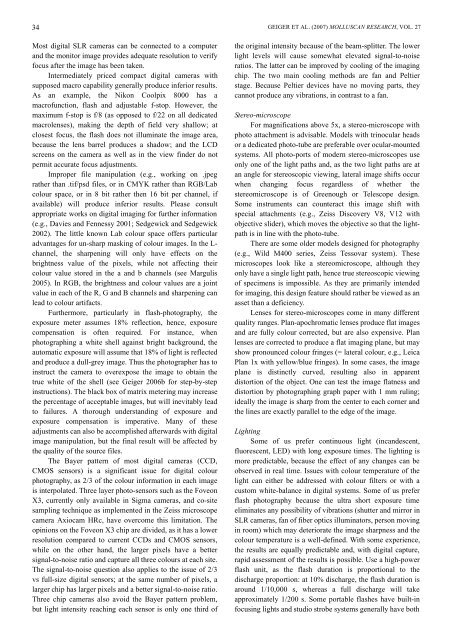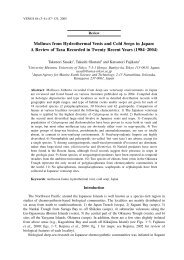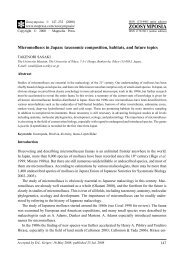Molluscan Research: Techniques for collecting, handling, preparing ...
Molluscan Research: Techniques for collecting, handling, preparing ...
Molluscan Research: Techniques for collecting, handling, preparing ...
You also want an ePaper? Increase the reach of your titles
YUMPU automatically turns print PDFs into web optimized ePapers that Google loves.
34<br />
Most digital SLR cameras can be connected to a computer<br />
and the monitor image provides adequate resolution to verify<br />
focus after the image has been taken.<br />
Intermediately priced compact digital cameras with<br />
supposed macro capability generally produce inferior results.<br />
As an example, the Nikon Coolpix 8000 has a<br />
macrofunction, flash and adjustable f-stop. However, the<br />
maximum f-stop is f/8 (as opposed to f/22 on all dedicated<br />
macrolenses), making the depth of field very shallow; at<br />
closest focus, the flash does not illuminate the image area,<br />
because the lens barrel produces a shadow; and the LCD<br />
screens on the camera as well as in the view finder do not<br />
permit accurate focus adjustments.<br />
Improper file manipulation (e.g., working on .jpeg<br />
rather than .tif/psd files, or in CMYK rather than RGB/Lab<br />
colour space, or in 8 bit rather then 16 bit per channel, if<br />
available) will produce inferior results. Please consult<br />
appropriate works on digital imaging <strong>for</strong> further in<strong>for</strong>mation<br />
(e.g., Davies and Fennessy 2001; Sedgewick and Sedgewick<br />
2002). The little known Lab colour space offers particular<br />
advantages <strong>for</strong> un-sharp masking of colour images. In the L-<br />
channel, the sharpening will only have effects on the<br />
brightness value of the pixels, while not affecting their<br />
colour value stored in the a and b channels (see Margulis<br />
2005). In RGB, the brightness and colour values are a joint<br />
value in each of the R, G and B channels and sharpening can<br />
lead to colour artifacts.<br />
Furthermore, particularly in flash-photography, the<br />
exposure meter assumes 18% reflection, hence, exposure<br />
compensation is often required. For instance, when<br />
photographing a white shell against bright background, the<br />
automatic exposure will assume that 18% of light is reflected<br />
and produce a dull-grey image. Thus the photographer has to<br />
instruct the camera to overexpose the image to obtain the<br />
true white of the shell (see Geiger 2006b <strong>for</strong> step-by-step<br />
instructions). The black box of matrix metering may increase<br />
the percentage of acceptable images, but will inevitably lead<br />
to failures. A thorough understanding of exposure and<br />
exposure compensation is imperative. Many of these<br />
adjustments can also be accomplished afterwards with digital<br />
image manipulation, but the final result will be affected by<br />
the quality of the source files.<br />
The Bayer pattern of most digital cameras (CCD,<br />
CMOS sensors) is a significant issue <strong>for</strong> digital colour<br />
photography, as 2/3 of the colour in<strong>for</strong>mation in each image<br />
is interpolated. Three layer photo-sensors such as the Foveon<br />
X3, currently only available in Sigma cameras, and co-site<br />
sampling technique as implemented in the Zeiss microscope<br />
camera Axiocam HRc, have overcome this limitation. The<br />
opinions on the Foveon X3 chip are divided, as it has a lower<br />
resolution compared to current CCDs and CMOS sensors,<br />
while on the other hand, the larger pixels have a better<br />
signal-to-noise ratio and capture all three colours at each site.<br />
The signal-to-noise question also applies to the issue of 2/3<br />
vs full-size digital sensors; at the same number of pixels, a<br />
larger chip has larger pixels and a better signal-to-noise ratio.<br />
Three chip cameras also avoid the Bayer pattern problem,<br />
but light intensity reaching each sensor is only one third of<br />
GEIGER ET AL. (2007) MOLLUSCAN RESEARCH, VOL. 27<br />
the original intensity because of the beam-splitter. The lower<br />
light levels will cause somewhat elevated signal-to-noise<br />
ratios. The latter can be improved by cooling of the imaging<br />
chip. The two main cooling methods are fan and Peltier<br />
stage. Because Peltier devices have no moving parts, they<br />
cannot produce any vibrations, in contrast to a fan.<br />
Stereo-microscope<br />
For magnifications above 5x, a stereo-microscope with<br />
photo attachment is advisable. Models with trinocular heads<br />
or a dedicated photo-tube are preferable over ocular-mounted<br />
systems. All photo-ports of modern stereo-microscopes use<br />
only one of the light paths and, as the two light paths are at<br />
an angle <strong>for</strong> stereoscopic viewing, lateral image shifts occur<br />
when changing focus regardless of whether the<br />
stereomicroscope is of Greenough or Telescope design.<br />
Some instruments can counteract this image shift with<br />
special attachments (e.g., Zeiss Discovery V8, V12 with<br />
objective slider), which moves the objective so that the lightpath<br />
is in line with the photo-tube.<br />
There are some older models designed <strong>for</strong> photography<br />
(e.g., Wild M400 series, Zeiss Tessovar system). These<br />
microscopes look like a stereomicroscope, although they<br />
only have a single light path, hence true stereoscopic viewing<br />
of specimens is impossible. As they are primarily intended<br />
<strong>for</strong> imaging, this design feature should rather be viewed as an<br />
asset than a deficiency.<br />
Lenses <strong>for</strong> stereo-microscopes come in many different<br />
quality ranges. Plan-apochromatic lenses produce flat images<br />
and are fully colour corrected, but are also expensive. Plan<br />
lenses are corrected to produce a flat imaging plane, but may<br />
show pronounced colour fringes (= lateral colour, e.g., Leica<br />
Plan 1x with yellow/blue fringes). In some cases, the image<br />
plane is distinctly curved, resulting also in apparent<br />
distortion of the object. One can test the image flatness and<br />
distortion by photographing graph paper with 1 mm ruling;<br />
ideally the image is sharp from the center to each corner and<br />
the lines are exactly parallel to the edge of the image.<br />
Lighting<br />
Some of us prefer continuous light (incandescent,<br />
fluorescent, LED) with long exposure times. The lighting is<br />
more predictable, because the effect of any changes can be<br />
observed in real time. Issues with colour temperature of the<br />
light can either be addressed with colour filters or with a<br />
custom white-balance in digital systems. Some of us prefer<br />
flash photography because the ultra short exposure time<br />
eliminates any possibility of vibrations (shutter and mirror in<br />
SLR cameras, fan of fiber optics illuminators, person moving<br />
in room) which may deteriorate the image sharpness and the<br />
colour temperature is a well-defined. With some experience,<br />
the results are equally predictable and, with digital capture,<br />
rapid assessment of the results is possible. Use a high-power<br />
flash unit, as the flash duration is proportional to the<br />
discharge proportion: at 10% discharge, the flash duration is<br />
around 1/10,000 s, whereas a full discharge will take<br />
approximately 1/200 s. Some portable flashes have built-in<br />
focusing lights and studio strobe systems generally have both




